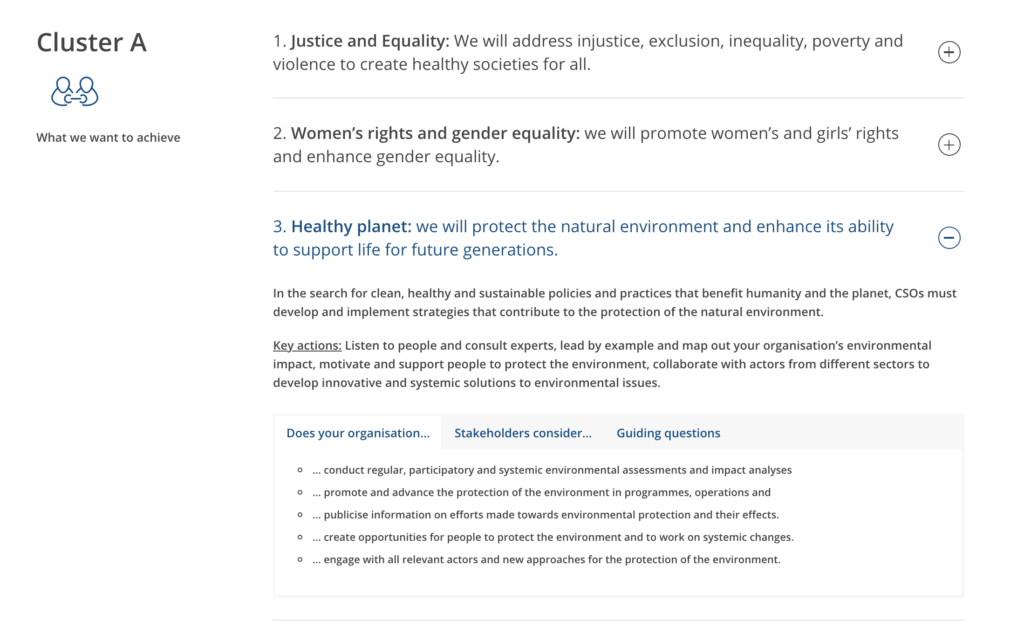The 22nd April marks the yearly event Earth Day: an international day dedicated to protesting and advocating for the protection of Earth and its natural environment. There are many days throughout the year that bring attention to the environment and climate crisis, but Earth Day has been one that has marked key moments for the protection of the environment, for example the signing of the 2016 Paris Agreement. Last year’s Earth Day saw millions of people engaged and active in events, campaigns and protests showing that these international days do hold a lot of power: they encourage mass mobilization, raise awareness and empower individuals, groups and communities to challenge leaders around the world to lift their heads and open their eyes and ears to the environmental crisis at hand.
At Accountable Now we call for our members, civil society organisations working around the world, to be accountable to the people they work for and with. But we also call for our members to be accountable to the Earth and its environment. Regarding the environment as a key stakeholder means that members have to consider the effect their work is having upon the environment as well as all other stakeholders: they must ensure that they mitigate their environmental impact and embed sustainability principles and values into planning, programming and policies. This is how Accountable Now regards environmental accountability and on this Earth Day we want to share with all CSOs five ways in which you can be accountable to the environment.
An environmental policy is the starting basis for any organisation that wants to improve and act upon its commitment to sustainability. An environmental policy provides an opportunity to understand how organisations impact the environment through their work and gives space to identify solutions that individuals, teams and offices can take up to instil sustainability in the heart of any organisation.
Creating an environmental policy will look different for all CSOs: size, office locations, mission and scope all will affect how a CSO creates their policy. Yet a standardised assessment can be made no matter where or how you work. By using the guidance tool developed by the Global Standard for CSO Accountability, you can take the first steps towards developing an environmental policy by assessing where your organisation stands today. This will lay the ground for any environmental policy and pose questions that will challenge CSOs to think about sustainability as something that should be present throughout all organisational activities.

If you want to learn more about how to create an environmental policy, check out our webinar made in partnership with our member MIO-ECSDE!
2. Targets
Environmental policies perform a great function of informing staff and stakeholders on how to behave, but it is also important to set targets that will help your organisation reach more ambitious sustainability goals. Through the development of an environmental policy, you will be able to identify areas where your organisation impacts the environment, e.g. number of international events attended, energy used within offices, waste created during daily operations or events. For areas like these, setting targets can be helpful for reaching realistic goals that will bring your organisation closer to fulfilling sustainability commitments.
3. Mechanisms
Measuring is key to understanding where change can be made. In order to set targets and track progress, mechanisms need to be put in place that ensure organisations can measure their sustainability practices. For example, does your organisation track how many events were attended by employees and the mode of transport that was used to reach these events? Does your organisation keep track of how many resources are used to facilitate daily work and activities? By measuring these it is possible to then find out the carbon footprint of your organisation using various online tools.
What becomes equally important is then ensuring mechanisms include an understanding across staff, of who is responsible for what so that the appropriate staff and volunteers can actively be involved in implementing any mechanisms in place.
4. Strategies
Once it is clear how and where your organisation should prioritise its sustainability activities, the next challenge is ensure they are integrated into the strategic decisions made within your organisation. Any environmental policies, targets and activities must be present throughout strategic discussions, from fundraising to project development. Just as CSOs are beginning to use a gender lens when planning, an environmental lens can be applied too.
5. Build Awareness
Policies, targets, mechanisms and strategies will not work without the buy-in of staff, volunteers, partners and stakeholders. Be loud about your commitment to sustainability principles and values and celebrate even the small achievements. At the same time, educate the people around you about how your organisation’s work does impact the environment and where it can improve. Most importantly, aim to involve as many people as possible in the development of an environmental policy, targets, mechanisms or strategies. Encourage feedback, look for insights and understand how an environmental can or cannot be applied to the various areas of your organisation’s work.

Accountable Now is a global membership platform. We support our members – and civil society at large – to be more transparent, responsive, impact-focused, and locally led. Interested in becoming a member?
Accountable Now is a member of Accountability Lab’s global translocal network.